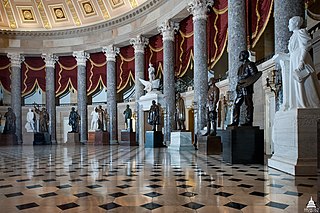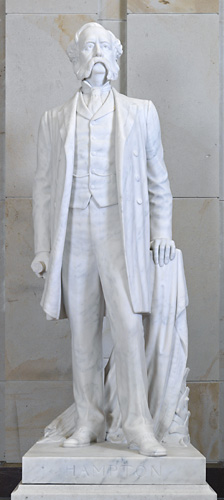
James Paul Clarke was a lawyer and politician from the Arkansas Delta during the Progressive Era. He served in public office over a period of almost 30 years, rising from the Arkansas General Assembly to Attorney General of Arkansas and later 18th Governor of Arkansas, ending his career in the United States Senate. In a period of Democratic Party hegemony known as the "Solid South", Clarke blended positions of the budding Populist movement, such as free silver and railroad regulation, with white supremacy and his gifted skills as an orator to popularity and electoral success.

The National Statuary Hall is a chamber in the United States Capitol devoted to sculptures of prominent Americans. The hall, also known as the Old Hall of the House, is a large, two-story, semicircular room with a second story gallery along the curved perimeter. It is located immediately south of the Rotunda. The meeting place of the U.S. House of Representatives for nearly 50 years (1807–1857), after a few years of disuse it was repurposed as a statuary hall in 1864; this is when the National Statuary Hall Collection was established. By 1933, the collection had outgrown this single room, and a number of statues are placed elsewhere within the Capitol.

Uriah Milton Rose was an American lawyer and Confederate sympathizer. "Approachable, affable, and kind," graceful and courteous, he was called "the most scholarly lawyer in America" and "one of the leading legal lights of the nation", "a towering figure in the...life of Little Rock". He was a founder of the American Bar Association, of which he was twice president, 1891–92 and 1901-02.

Frederick Wellington Ruckstull was a French-born American sculptor and art critic.

The National Statuary Hall Collection in the United States Capitol is composed of statues donated by individual states to honor persons notable in their history. Limited to two statues per state, the collection was originally set up in the old Hall of the House of Representatives, which was then renamed National Statuary Hall. The expanding collection has since been spread throughout the Capitol and its Visitor's Center.

Daisy Bates was an American civil rights activist, publisher, journalist, and lecturer who played a leading role in the Little Rock Integration Crisis of 1957.

Benjamin Matthew Victor is an American sculptor living and working in Boise, Idaho. He is the only living artist to have three works in the National Statuary Hall in the United States Capitol. He is currently sculpting his fourth statue for the Statuary Hall, of Daisy Bates. He was only 26 years old when his first statue, Sarah Winnemucca, a Paiute activist in Nevada, was dedicated in the Hall in 2005, making him the youngest artist to ever be represented in the Hall. In 2014, his sculpture of Norman Borlaug, "the father of the Green Revolution," was dedicated in the National Statuary Hall and in 2019, his statue of Chief Standing Bear, a Native American rights leader, was dedicated in the National Statuary Hall making him the only living artist to have three sculptures in the Hall.
Barry Goldwater is a bronze sculpture depicting American politician and businessman of the same name by Deborah Copenhaver Fellows, installed at the United States Capitol's National Statuary Hall, in Washington, D.C., as part of the National Statuary Hall Collection. The statue was donated by the U.S. state of Arizona in 2015 and replaced a statue of John Campbell Greenway, which the state of Arizona gifted to the collection in 1930.

William Jennings Bryan is a bronze sculpture depicting the American politician of the same name by Rudulph Evans, which was installed in the United States Capitol's National Statuary Hall, in Washington, D.C., as part of the National Statuary Hall Collection. The statue was gifted by the U.S. state of Nebraska in 1937.

James Paul Clarke is a marble sculpture depicting the American politician of the same name by Pompeo Coppini, installed in the United States Capitol's National Statuary Hall Collection, in Washington, D.C., as one of two statues gifted by the U.S. state of Arkansas. The 6 foot 10 inch tall statue was placed in the Hall in 1921. The work cost $7,500. and was unveiled in Washington in 1921.

John C. Calhoun is a marble sculpture depicting the American statesman of the same name by Frederick Ruckstull, installed in the United States Capitol's crypt, in Washington, D.C., as part of the National Statuary Hall Collection. The statue was gifted by the U.S. state of South Carolina in 1910.

The National Statuary Hall Collection holds statues donated by each of the United States, portraying notable persons in the histories of the respective states. Displayed in the National Statuary Hall and other parts of the United States Capitol in Washington, D.C., the collection includes two statues from each state, except for Virginia which currently has one, making a total of 99.

Wade Hampton III is a 1929 marble sculpture depicting the military officer and politician of the same name by Frederick Ruckstull, installed in the United States Capitol, in Washington D.C., as part of the National Statuary Hall Collection. It is one of two statues donated by the state of South Carolina. The statue was accepted in the collection by Duncan Heyward on June 10, 1929.

Helen Keller is a bronze sculpture depicting the American author and political activist of the same name by Edward Hlavka, installed in the United States Capitol Visitor Center's Emancipation Hall, in Washington, D.C., as part of the National Statuary Hall Collection. The statue was gifted by the U.S. state of Alabama in 2009, and replaced one depicting Jabez Lamar Monroe Curry, which had been donated in 1908.

Andrew Jackson is a 1928 bronze sculpture of Andrew Jackson by Belle Kinney Scholz and Leopold Scholz, installed in the United States Capitol, in Washington D.C., as part of the National Statuary Hall Collection. It is one of two statues donated by the state of Tennessee. The statue was accepted into the collection by Senator Kenneth McKellar on April 16, 1928.

Julius Sterling Morton, also known as J. Sterling Morton, is a 1937 bronze sculpture of Julius Sterling Morton by Rudulph Evans, installed in the United States Capitol Visitor Center, in Washington, D.C., as part of the National Statuary Hall Collection. It is one of two statues donated by the state of Nebraska. The sculpture was accepted into the collection by Congressman Karl Stefan of Nebraska on April 27, 1937.

A statue of American Founding Father and U.S. President Thomas Jefferson by the French sculptor David d'Angers stands in the Capitol rotunda of the U.S. Congress. Jefferson is portrayed holding a copy of the United States Declaration of Independence, which he mainly drafted in 1776 as a member of the Committee of Five during the Second Continental Congress. The painted plaster model also stood in the chambers of the New York City Council.

There are several works of art in the United States Capitol honoring former leaders of the Confederate States of America and generals in the Confederate States Army, including seven statues in the National Statuary Hall Collection, busts and portraits.
A bronze statue of American civil rights activist Daisy Bates is installed at the United States Capitol's National Statuary Hall, in Washington, D.C., as part of the National Statuary Hall Collection. It was designed by artist Benjamin Victor. Unveiled in May 2024, the sculpture represents the U.S. state of Arkansas, replacing one of U. M. Rose.
A statue of Johnny Cash is slated to be installed in the U.S. Capitol Building, in Washington, D.C., as part of the National Statuary Hall Collection. The sculpture will represent Arkansas and replace a statue of James P. Clarke.















